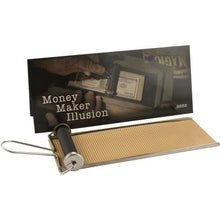MONEY MAKER ILLUSION!
Deluxe Version
This magic trick appears to turn plain paper into real dollar bills!
This is a very professional looking and well made prop!
Place a white piece of paper inside the Magic Money Maker and roll the printing bar. As the bar rolls along the white paper becomes a real dollar bill (or whatever you secretly load). Includes Money Maker Illusion and instructions. Also includes instructional video download!
Dimensions: 10 x 4.3 x 1.5 inches
Use your own real bills they are not included.
Bill sized white paper is easily made from regular paper if needed.
This is a magic effect and does not actually print real currency.
Photographs and/or video are for demonstration purposes only.
Colors of actual product may vary due to the difference in screened devices.
This is a magic trick! This prop does not actually print. It will only appear to 'print' what you secretly load into it.
A brief history of the Money Maker Effect:
1st. in 1891 to Alois Miklas of Vienna, Austria-Hungary, with assignor to
George Borgfelt & Co. of New York (toy manufacturer)
Patent #453,201
2nd. in 1905 to William Horrocks of Littlefalls, New York, as a toy.
This was the first flat model. Patent #783,203
3rd.in 1909 to Frank L. Oleson of Chicago, Illinois
4th. was issued in 1923 to Fred Densmore & Christian Kessler. This model was
the one that influenced the Thayer Owen models. This is also the model that was
used by Laurel and Hardy in their 1942 film A Haunting We Will Go, which also
featured that great loved Illusionist Dante. Patent #1,473,214
There have been lots of variations built and manufactured over the years, but the
S.S. Adams Co. probably made more versions of the money maker than anyone else.
As far as the very first? Bart Whaley in his Encyclopedic Dictionary of Magic
says that a money maker was marketed in W.F. Hamley's catalog in 1882 as
"The Marvelous Printing Machine."
1st. in 1891 to Alois Miklas of Vienna, Austria-Hungary, with assignor to
George Borgfelt & Co. of New York (toy manufacturer)
Patent #453,201
2nd. in 1905 to William Horrocks of Littlefalls, New York, as a toy.
This was the first flat model. Patent #783,203
3rd.in 1909 to Frank L. Oleson of Chicago, Illinois
4th. was issued in 1923 to Fred Densmore & Christian Kessler. This model was
the one that influenced the Thayer Owen models. This is also the model that was
used by Laurel and Hardy in their 1942 film A Haunting We Will Go, which also
featured that great loved Illusionist Dante. Patent #1,473,214
There have been lots of variations built and manufactured over the years, but the
S.S. Adams Co. probably made more versions of the money maker than anyone else.
As far as the very first? Bart Whaley in his Encyclopedic Dictionary of Magic
says that a money maker was marketed in W.F. Hamley's catalog in 1882 as
"The Marvelous Printing Machine."
Restrictions may apply. Packaging may vary.
Not responsible for use or misuse of this or any other product.
Video and/or photographs are for demonstration purpose only.
Colors of product may vary due to the differences in device displays.





